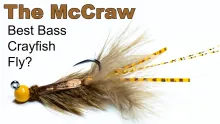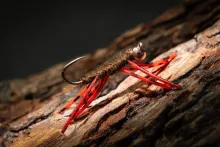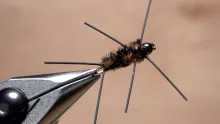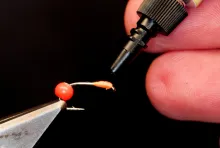Wriggling is a coiling and uncoiling behavior of a larva or worms body. It is a characteristic movement of Chironomids as shown at the start of this video clip and also often seen in the annelids--the phylum consisting of terrestrial and aquatic worms as well as leeches. Chironomid larva and annelids are generally thought to be what the San Juan Worm emulates. The bobber stop worm tied in this video is a San Juan Worm variant designed to simulate this behavior by using tungsten beads to weight the ends of a worm body built on a flexible braid--much like the Bolas weapon used in South America. The thinking is that when a bolas-weighted fly encounters an obstacle, like a rock when the fly is presented using bottom bouncing, the weighted ends can bounce off of it or tend to wrap around it producing a wriggling-like action.
Bobber Stop Worm Recipe
Hook: Mustad R50 (like the 94840) size 10-14 or other suitable hook that has a shank about 3/4 inch (17 mm) long. I also like a standard shank length, extra wide gap, hook like the Tiemco 102Y or a short shank, wide gap hook, like the Firehole 637.
Thread: Nanosilk 50D black
Bead on Hook Shank: 3mm gold countersunk brass bead. Can also use Tungsten beads but you may want to use a reduced diameter bead to avoid making the fly so heavy that it sticks rather than bottom bounces. Thread the bead on the hook shank and move it up to behind the hookeye and lay down a thin thread base behind it along the length of the hook shank. Then the bead is more or less centered on the hook shank. The thinking behind the gold bead is that the flash will attract the fish to bite there--near where the hook point is placed. A bite out on the ends of the fly arms is less likely to end up with a hooked fish.
Beading cord: Low-Vis Green Suffix 832 braid. I Use 10 lb test braid or less. Within reason, given the size of the fish your are targeting, the thinner the beading cord, the better the wriggling action of the finished fly with the trade-off of ever-lessening durability. The 6 or 8 lb test braid seems a good compromise for flexibility vs. durability. 10 lb test braid leads to a less flexible fly but one that more readily keeps its arms extended.
Bobber stops: Small or medium red silicone bobber stops. I buy them from affiliates listing on the Amazon, Walmart, Ebay, Alibaba and Temu websites. Silicone bobber stops used to tie the Bobber Stop Worm (BSW) are translucent football shaped forms that impart a realistic semi-transparent segmented look to the BSW. The bobber stops shown in the video, are the Aktudy brand found on the Walmart website and cost a little less than 8 bucks for 300 or those on the Temu site for about $2/100.
Bola Style Weighting: 2 to 2.5 mm black nickel tungsten beads threaded on and slid to the knotted end of beading cord. This weighting is inspired by the South American bolas (AKA boleadora) weapon that consists of two or three end-weighted cords tied together at a common point. When a bola is thrown and hits a target it tends to wrap around it. The bola wrapping action, as employed here, is in the end weighting of the worm arms that cause the Bobber Stopper worm to wrap or wriggle when it encounters obstructions like when bottom bouncing.
Worm arms: Tie an improved surgeon's loop on a 10 inch (25 cm) piece of braid and cut off the loop and tag ends to idea is the have a large knot to butt the Bola weighting beads against. Then thread on 4-7 bobber stops depending on how large a fly is desired. Make two of these.
Assembly: Thread the tag end braid forming the BSW arms in opposite directions through the Gold bead. Lash in place on either side of gold bead and on out to one bobber stop on either side. trim tag ends. Wind thread out to hook eye and whip finish.
Cement: UV setting resin or waterproof superglue applied on whip finish and over the thread base on hook shank after the fly is tied off.
Chapters:
00:00 Flies Should Emulate the Wriggling Behavior of the Natural Larvae and Worms
1:00 Tying a Bobber Stop worm
8:00 The wide range of Bobber Stop material
8:38 The Bobber Stop's Superpower: Phosphorescence-- i.e. Glow in the Dark nymphs
8:52 Tying a Lumen Caddis
9:29 Tying a Lumen Crane
10:04 Bobber Stop Terrestrials
_______________________
Gone fishing, troutracker[at]yahoo[dot]com
- Log in to post comments







